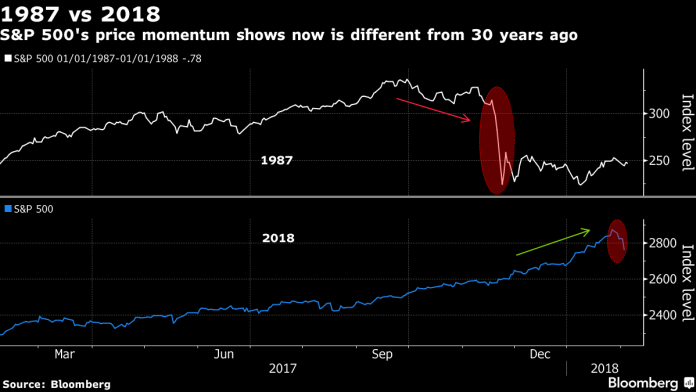
NEW YORK – There’s new leadership at the Fed, and stocks are buckling amid losses in bonds. But that’s about as far as anyone should take comparisons between today’s markets and those before the Crash of 1987, says Jeff deGraaf, a widely followed U.S. technical analyst.
From price momentum and breadth to the way bank shares are trading, too many differences exist to link conditions now to the collapse 30 years ago, wrote the founder of Renaissance Macro Research. Add stable credit spreads, and Friday’s slump looks more like a pause in a rally that just lured $20 billion to the biggest S&P 500 ETF.
“Very little about last week leads us to believe a crash environment has commenced,” deGraaf, the top-ranked technical analyst in Institutional Investor’s annual survey for 11 straight years through 2015, wrote in a note.
Count clients at Goldman Sachs Group Inc. among those who have inquired about a repeat of Black Monday, when the Standard & Poor’s 500 index plunged 20 percent in one day. David Kostin, the firm’s chief U.S. equity strategist, said many investors were surprised by the violent start to 2018. After rising 50 percent in two years and 5.6 percent last month, the S&P 500 posted its worst drop since January 2016 last week amid signs of budding inflation and surging yields.
People making the comparison should consider the solid earnings behind this year’s rally, Kostin wrote. Moreover, he noted, 1987 was a statistical outlier. In the 11 other years since 1950 that started with a January gain of more than 5 percent, all saw higher prices from February to December, with gains averaging 17 percent.
“By focusing on 1987, investors overlook other historical episodes that suggest a much better outlook for U.S. equities,” Kostin wrote in a note.
While monetary easing and deregulation will eventually “sow the seeds” for the next bear market, it’s too early to panic, said deGraaf. Stock momentum is still strong, unlike in late 1987. The S&P 500 hit a record a week ago, as did the NYSE cumulative advance-decline line, which measures the number of daily gains minus declines. A large percentage of stocks were trading above their 65-day moving average at the high. While concern over yields is up, so are financial stocks.
None of this was true in October 1987. Back then, the S&P 500 had been drifting lower for two months after hitting a record, slipping below its 50-day average well before the plunge. Bank shares had trailed the market for a year as yields went up.
Also comforting now is resilience in the credit market. The extra yield that investors demand for owning high-risk bonds versus low-risk bonds has barely moved despite a surge in 10-year Treasury yields, a sign that there is little financial stress.
“If inflation or higher yields were hurting business prospects into the future, we’d expect to see BB spreads deteriorate more quickly than BBB, but it’s not happening,” deGraaf said.
Perhaps most importantly: even after their recent rise, 10-year yields are below 3 percent. In 1987, rates were above 10 percent.
Lu Wang is a Bloomberg News staff writer.












